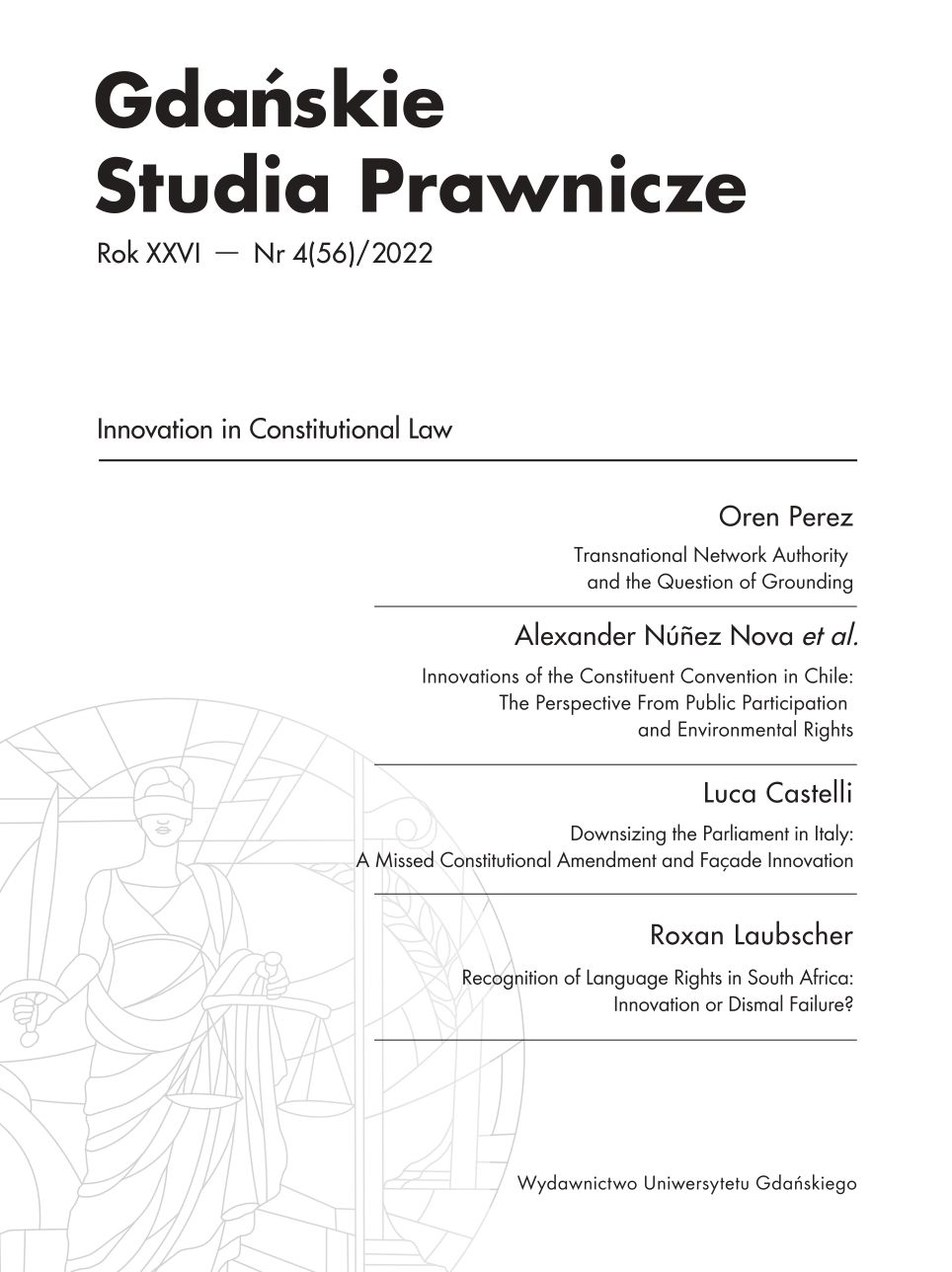Zmniejszenie liczby członków parlamentu we Włoszech: chybiona zmiana Konstytucji i fasadowa innowacja
DOI:
https://doi.org/10.26881/gsp.2022.4.04Słowa kluczowe:
Włochy, zmniejszenie liczby członków parlamentu, dwuizbowość symetryczna, konstytucjonalizm populistyczny, innowacja fasadowaAbstrakt
We wrześniu 2020 r. we Włoszech odbyło się referendum w sprawie zmniejszenia liczby deputowanych, w którym prawie 70% głosujących zaaprobowało poddane pod głosowanie zmiany. W związku z powyższym od następnej kadencji izb, która rozpocznie się w 2023 r., całkowita liczba deputowanych zostanie obniżona z 945 do 600, czyli o ponad jedną trzecią. Liczba członków Izby Deputowanych zostanie zmniejszona z 630 do 400, a członków Senatu – z 315 do 200. W ocenie autora, przyjęte w referendum zmiany Konstytucji mają jedynie pozornie innowacyjny charakter, gdyż nie rozwiązały problemu braku równowagi pomiędzy dwiema izbami włoskiego parlamentu.
Downloads
Bibliografia
Albert R., Constitutional Amendments. Making, Breaking, and Changing Constitutions, Oxford Uni-versity Press 2019.
Bassini M., Pollicino O., “Nothing left to do but vote – The (almost) untold story of the Italian constitutional reform and the aftermath of the referendum”, VerfBlog, December 15, 2016.
Benasaglio Berlucchi A., “Understanding the populism of the Five Star Movement – and its continuity with the past”, LSE Blog, August 26, 2021.
Blokker P., “Populist Constitutionalism and Meaningful Popular Engagement”, VerfBlog, May 4, 2017.
Cartabia M. and Lupo N., The Constitution of Italy: A Contextual Analysis, Bloomsbury 2022.
Castelli L., Il Senato delle Autonomie. Ragioni, Modelli, Vicende, Padova, Cedam 2010.
Fusaro C., “Reducing the Size of the Italian Parliament: A Limited Constitutional Reform with No Risks and Some Benefits”, Int’l J. Const. L. Blog, Sept. 16, 2020.
Koch C., “Varieties of populism and the challenges to Global Constitutionalism: Dangers, promises and implications”, Global Constitutionalism 2021, vol. 10, issue 3.
Kreilinger V., “Downsizing the German Bundestag”, SOG Working Paper 2020, no. 60.
Invernizzi Accetti C., “Italy’s new experiment in populist technocracy”, Financial Times, September 6, 2019.
Luther J., Passaglia P., Tarchi R. (eds), A world of second Chambers. Handbook for constitutional studies on bicameralism, Milano 2006.
Martinico G., Filtering Populist Claims to Fight Populism: The Italian Case in a Comparative Perspec-tive, Cambridge University Press 2021.
Murphy J., “Size and representativeness of legislatures in historical evolution; observations from the anglo-american context”, SOG Working Paper 2020, no. 58.
Palermo F., “Reducing the Size of the Italian Parliament: The Wrong Means to the Right End”, Int’l J. Const. L. Blog, Sept. 18, 2020.
Palermo F., “Two Almost Identical Chambers Doing the Same Job Twice: On the lowering of the voting age and the lack of a constitutional strategy in Italy”, VerfBlog, July 13, 2021.
Patterson S.C., Mughan A. (eds), Senates. Bicameralism in the Contemporary World, Ohio State University Press 1999.
Pinelli C., “The Populist Challenge to Constitutional Democracy”, European Constitutional Law Review 2011, vol. 7.
Rosa F., “Reducing the Size of the Italian Parliament: Why I will be voting No”, Int’l J. Const. L. Blog, Sept. 17, 2020.
Roznai Y., Unconstitutional Constitutional Amendments: The Limits of Amendment Powers, Oxford University Press 2017.
Russell M., “The failed Senate reform in Italy: international lessons on why bicameral reforms so often (but not quite always) fail”, The Constitution Unit, July 20, 2018.
Urbinati N., “The Italian Five Star Movement for foreigners”, Rivista il Mulino, March 1, 2018.

 Uniwersyteckie Czasopisma Naukowe
Uniwersyteckie Czasopisma Naukowe




